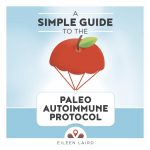Food as Medicine
If you’re new to the Paleo Autoimmune Protocol, a lot of your favorite foods are suddenly off the table and you may wonder what you can eat during the elimination phase. In today’s podcast, we’ll be sharing AIP food swaps for some of the foods you miss the most! We’ll also share some powerful superfood combinations. We all know that nutrient density is a key foundation for autoimmune health. What you may not know is that some foods are more nutritious when eaten together. My guest is Annie Rubin. She is a Registered Dietitian Nutritionist and an AIP Certified Coach. She’s also a fellow autoimmune warrior living with rheumatoid arthritis herself.
Listen to the Show
- Subscribe to my podcast through your favorite podcast app: iTunes, Stitcher, Google, TuneIn, Spotify, Amazon, etc.
- You can also listen to the episode right here through the player below, and if you subscribe to my newsletter you’ll get notified of future episodes.
Podcast: Play in new window | Download
Show Notes
- Intro (0:00)
- 2 Million Downloads Giveaway! (2:22)
- This podcast recently passed a huge milestone: 2 million downloads! And that’s thanks to all of you!
- To celebrate, I’m a hosting a huge giveaway on my website with over $1,000 in prizes! I’ll choose the winners on 1/28/22.
- There are four US-only prizes and four international prizes. So, no matter where you live around the world, you are eligible to enter. Here’s what you can win:
- $100 gift certificate to ShopAIP: an online store dedicated to the paleo autoimmune protocol, with hundreds of items for the elimination phase, and products labeled by reintroduction category as well. (US only)
- $100 gift certificate to Luminance Skincare: a nontoxic skincare company with a complete face and body care line, including cleansers, toners, moisturizers, masks, acne serum, sunscreen, haircare, and more. (US only)
- $100 gift certificate to Sip Herbals: a high-quality line of AIP-friendly, caffeine-free, herbal coffee substitutes that are absolutely delicious. In addition to their Original coffee flavor, you can buy Salted Caramel, Dirty Chai, Mocha, and Vanilla. (US only)
- $100 of bone broth from Bonafide Provisions: the highest quality AIP-friendly broth that you can find in the grocery store. They use organic ingredients and traditional slow cooking methods for a rich, gelatinous, healing broth. You’ll think you made it in your own kitchen. (US only)
- An annual membership to Chronicon ($250 value): an online community for people with chronic illness. Their mission is to help you feel supported, celebrated, and thrive. In addition to the personal connections you’ll make, there are videos, podcasts, guided meditations, educational workshops, and more. (International prize)
- An annual membership to Autoimmune Strong ($179 value): an online fitness program designed specifically for people with autoimmune disease. If you’ve been struggling with exercise intolerance where movement often causes flares, this program can help you overcome it. (International prize)
- Admission to the online class: Exploring Creative Connection Through Visual Journaling ($175 value). The mind-body connection is a big part of autoimmune health, and this class is a resource for stress management, emotional expression, creativity, and fun. (International prize)
- An annual membership to Real Plans ($79 value): a meal planning app with over 200 Paleo AIP recipes, it makes meal planning easy by generating grocery lists, defrost reminders, and timelines for how long it will take to prepare and cook each recipe. (International prize)
- Meet Annie Rubin (5:15)
- Annie Rubin. is a Registered Dietitian Nutritionist, an AIP Certified Coach, and a fellow autoimmune warrior living with rheumatoid arthritis herself.
- She was diagnosed at age 28. She had just finished her first Ironman triathlon and assumed the pain she was experiencing was the result of athletic injuries. She went to physical therapy, but she didn’t recover the way she had in the past. Instead, her pain kept getting worse. After months with no progress, her PT reached out to her sports medicine doctor and suggested further testing. Rheumatoid factor came back positive which led to her diagnosis. She was put on medication and went into remission fairly quickly.
- Years later, pregnancy and childbirth pushed her out of remission, and that inspired diet and lifestyle changes. Medication on its own was no longer enough. She had already gone gluten-free and dairy-free to address some digestive issues. She did the Paleo Autoimmune Protocol to reduce inflammation and got good results. She’s been able to reintroduce some foods and eats a paleo-style diet now. She also prioritizes sleep and stress management. She’s active every day but chooses exercise that’s easier on her body. And she also made some big changes: changing her career and moving to a new home, and both were positive steps for her health.
- Healthy Food Swap #1: Pasta (10:37)
- The AIP real food version is spiralized vegetables.
- Traditional refined wheat pasta is low in nutrition, low in fiber, and high in processed carbohydrates. For that reason, it can cause blood sugar swings which can increase inflammation. The gluten contained in the wheat can also be inflammatory.
- Spiralized vegetables have vitamins, minerals, and antioxidants. They also contain beneficial fiber. There’s a reason vegetables are the base of the AIP Food Pyramid.
- Note: AIP boxed pasta is available now and can be a nice treat once in a while. And while it is gluten-free and an improvement over wheat pasta, it’s not as nutrient-dense as fresh, spiralized vegetables. For this reason, AIP Pasta can cause blood sugar swings, too. So, keep it in the treat category, and choose spiralized veggies as your staple.
- Resource: Paleo AIP Spiralizer Recipe Roundup.
- Healthy Food Swap #2: Oatmeal (15:43)
- There are AIP N’oatmeal recipes, but there are also many other ways to start your mornings on the AIP. Breakfast soup is a favorite of many of us!
- Oatmeal has a blend of positive and negative qualities, which is why it’s out during the elimination phase of the AIP but can then be tested later during the reintroduction phase. Oats do contain protein and fiber that helps balance the blood sugar impact of their carbohydrate content. They also contain a special type of fiber called beta glucan that research shows may lower cholesterol. And they contain antioxidants which help reduce inflammation. However, they also contain antinutrients that can interfere with the absorption of vitamins and minerals. The other downside is that they don’t have much flavor on their own, so most people add a lot of sugar and dried fruit, which can cause blood sugar dysregulation and inflammation. This is why oats are out during the elimination phase of the AIP. If you’re like to try reintroducing them during the reintroduction phase, here are some tips to maximizing the pros and minimizing the cons: (1) Choose a certified gluten-free brand. While oats are naturally gluten-free, gluten cross-contamination is common during processing. (2) Add a healthy fat to help balance the blood sugar impact and increase the absorption of fat-soluble vitamins. (3) Choose fresh fruit instead of dried fruit. (4) And if you want to add a little honey or maple syrup, try a smaller amount.
- One benefit of the AIP is that it expands our idea about what we can eat for breakfast. Both Annie and Eileen fell in love with breakfast soup during the elimination phase. Even though they’ve both reintroduced many foods back into their diet, this is still their favorite way to start the day. Like oatmeal, it’s warm, satiating, and a comforting way to start the day. Unlike oatmeal, it has benefits without the downsides. Bone broth has gut healing properties, and soup is flexible and easy to make nutrient-dense by adding different proteins and vegetables.
- Resource: 50 Paleo AIP Breakfast Recipes.
- Healthy Food Swap #3: Bread (22:04)
- There are now some wonderful AIP bread recipes online, and having a favorite bread recipe can make the Paleo Autoimmune Protocol more enjoyable and more sustainable. The good news is that AIP bread has some nutrition. The bad news is that its nutrition doesn’t compare to vegetables, meat, or seafood. So, consider AIP bread a treat rather than a staple in your diet.
- The problems with wheat bread: Gluten can increase intestinal permeability, overstimulate the immune system, and shift the microbiome into dysbiosis by overfeeding the wrong type of bacteria. That’s why many people with autoimmune disease choose to avoid gluten.
- AIP bread is gluten-free, higher in fiber than wheat bread (which moderates the blood sugar impact), and AIP flours also contain some beneficial nutrients. Cassava flour contains vitamin C. Tigernut flour contains potassium, magnesium, and zinc. Coconut flour contains medium chain triglycerides that have antimicrobial benefits.
- Resource: AIP Bread Recipes.
- Mental Health on a Healing Diet (25:02)
- As we share these healthy food swaps and the choices we make on a healing diet, it’s very important to still have joy in eating. If our diet feels too restrictive, it can challenge our mental health. Thankfully there are now 40+ cookbooks and thousands of recipes online. It’s easier than ever to eat delicious and varied AIP meals.
- Resources:
- Thank You To Our Podcast Sponsor – Luminance Skincare (27:19)
- This week, I’m highlighting their winter facecare routine. When the weather turns cold and the heat is on inside our homes, our skin can suffer. We need some TLC. Luminance has wonderful products to replenish your skin. To begin, their cream cleanser is carefully formulated to avoid drying out your skin. It’s a water-soluble lotion that applies like a face cream and then rinses away. It melts away makeup and leaves your face feeling conditioned, comfortable and hydrated. Their rosewater toner then gently restores the pH value of your skin, which is especially important if you have hard water at home. Their nourishing serum is designed to deliver a concentrated dose of nutrients to the deepest layers of your skin, which are often missed in a skincare routine. And the final step is their deep hydration moisturizer. Rich in nourishing ingredients but not greasy, it keeps your skin moisturized all day long.
- Whereas conventional skincare products are full of chemicals that can hurt our bodies, Luminance is made from ingredients that nourish. Their products are natural, organic, wildcrafted, non-GMO, and gluten-free (and they’re even made in a dedicated gluten-free facility). They’re also handmade in small batches within the United States.
- They have a complete face and body care line, including cleansers, toners, moisturizers, masks, acne serum, sunscreen, haircare, and more.
- Place an order here, and use the code HELIX for 10% off your first order.
- Healthy Food Swap #4: White Rice (29:17)
- The AIP real food substitute is cauliflower rice.
- Because the bran has been stripped from white rice, both the nutrients and the anti-nutrients have been stripped as well. So, that means it’s easy to digest but not very nutrient-dense. It’s also high on the glycemic index which can cause blood sugar spikes.
- Cauliflower “rice” is very nutrient-dense. It’s rich in vitamins C, K and folate. It’s also a sulfur-rich vegetable which can protect against cancer and oxidative stress, and is also anti-inflammatory. Terry Wahls recommends 3 categories of vegetables to include in your daily diet: greens, brightly colored, and sulfur-rich. Cauliflower “rice” fills the sulfur-rich category.
- Resources:
- Recipe: 4 Flavors of Cauliflower Rice.
- Article: What’s Up with White Rice?
- Healthy Food Swap #5: Cheese (32:58)
- AIP “cheese” recipes are usually comprised of vegetables, gelatin, and nutritional yeast, crafted to create a “cheesy” flavor and texture.
- Potential problems with dairy: Many people have trouble digesting lactose, the sugar naturally contained in dairy. And casein, the protein in dairy, can also cause inflammation. In addition, dairy naturally contains insulin-like growth factors that can suppress antioxidants. And non-organic dairy can contain additional hormones, antibiotics, and pesticide residue, adding to the toxic load on your body.
- The benefits of AIP “cheese”: it’s naturally dairy-free so has none of the negatives noted above. The vegetable ingredients contain nutrients, antioxidants, and fiber. The gelatin has its own beneficial properties. And nutritional yeast which is used for a “cheesy” flavor is high in B12, which supports metabolism, methylation, and red blood cell production.
- Recipes:
- Healthy Food Swap #6: Refined Sugar (36:42)
- While refined sugar is excluded on the AIP, natural sugars in moderation are allowed (honey, molasses, maple syrup, etc.)
- Refined sugar is basically an empty calorie. All beneficial nutrition and fiber has been stripped out, and sugar is all that remains.
- Fruit is the healthiest source of natural sugar. It contains plenty of fiber to help moderate the blood sugar impact, and also contains abundant vitamins and phytonutrients.
- Natural added sugars (honey, molasses, maple syrup, etc.) are somewhere in between. They do have some beneficial micronutrients, and they aren’t as highly refined. However, they can still have a blood sugar impact. Moderation is important. Annie recommends limiting your intake to 2-6 teaspoons of added sugar per day. That’s easy to measure at home. If you’re looking at a store-bought, packaged AIP treat, look at the nutrition label. There will be a line that says “added sugars”. 4 grams equals 1 teaspoon.
- Resources:
- Thank You to Our Podcast Sponsor – Functional Nutrition Alliance (43:52)
- Full Body Systems is their internationally acclaimed, 10-month online functional nutrition immersion training program.
- It’s designed by world-renowned educator, Andrea Nakayama. Many of you know her as one of my most popular podcast guests. Her unique way of working with patients often leads to results where other practitioners hit dead ends. This program teaches you to do the same.
- If you’re already trained as a health coach, nutritionist, or medical practitioner and want to more effectively help your clients break through healing plateaus, this class is for you!
- And if you’re an aspiring practitioner just getting started, this might be the only training you need.
- You’ll gain detailed knowledge of all the systems in the body, how they interact, how problems develop, and how to personalize diet and lifestyle recommendations for each unique client.
- Enrollment is currently open. To learn more, visit FxNutrition.com/Eileen.
- Nutritious Combo #1: Dietary Fats & Fat-Soluble Vitamins (45:17)
- Vitamins come in two types: water-soluble and fat-soluble.
- B vitamins and vitamin C are water-soluble and easily absorbed through the lining of our small intestine directly into our bloodstream.
- Vitamins A, D, E, and K are fat-soluble and they need assistance to be absorbed by our body. They’re absorbed the same way dietary fats are. They require the release of bile and pancreatic enzymes to break them down into components that can eventually be packaged into lipoproteins that are then carried into the lymphatic system for eventual delivery to our bloodstream. Dietary fats are needed to stimulate this process. That’s why it’s important to eat a healthy fat at every meal, in order to absorb all the nutrition that meal contains, especially the fat-soluble vitamins. This is also true if you are taking fat-soluble vitamins as supplements – always eat them with food that contains some fat.
- There are also some foods that contain the combination of natural fats and fat-soluble vitamins in one package. Salmon is a great example.
- Resources:
- Nutritious Combo #2: Iron and Vitamin C (49:42)
- Iron comes in two types as well: heme iron from animal sources and non-heme iron from plant sources.
- Our body absorbs heme iron very well but struggles to absorb non-heme iron.
- One way to boost the absorption of plant-based iron is to eat vitamin C rich foods alongside. One study found that this can increase the absorption 3-fold. Leafy greens are a wonderful source of plant-based iron, and citrus is a wonderful source of vitamin C. Creating a citrus-based dressing (or simply squeezing some lemon juice on top of your greens) can aid the absorption. Other vitamin C rich foods include cabbage, cauliflower, broccoli, kale, cantaloupe, strawberries, kiwi, papaya, and mango. This is a great example of why fruit is a nutrient-dense way to satisfy your sweet cravings, because they have nutrition that can even amplify the nutrition of the other foods on your plate.
- Another way to boost the absorption of plant-based iron is to eat animal foods alongside, because heme iron also boosts the absorption of non-heme iron.
- Resource Podcast: Ep. 81 – Anemia and Autoimmune Disease.
- Nutritious Combo #3: Sulforaphane and Selenium (53:14)
- Sulforaphane is the antioxidant found in cruciferous vegetables (cauliflower, cabbage, kale, broccoli, Brussels sprouts, etc.) It’s also high in broccoli sprouts.
- Selenium is an antioxidant found in many AIP foods including oysters, halibut, sardines, chicken, and mushrooms. It’s also high in brazil nuts and eggs (AIP reintros).
- Both of these antioxidants independently help reduce inflammation and protect against cancer, but they’re even more powerful together. Combine them within a meal to supercharge their benefits.
- Outro (56:04)
- Annie Rubin specializes in nutrition consulting for people with autoimmune disease. She works with people 1:1 and is also developing a group class as well. You can connect with her through her website, or on Instagram or Facebook.
- Eileen (your podcast host) is the author of multiple books, written to help people thrive with autoimmune disease. Learn more on the Books Page.
- If you like this podcast, follow or subscribe through your favorite podcast app. You can also subscribe to Eileen’s biweekly newsletter.
- Check out the entire archive of podcast episodes.
You May Also Be Interested In
Spreading the Word
If you like the podcast, please leave a positive review in iTunes. It would mean the world to me, and also helps others find the podcast. Here are some quick instructions using your iPhone:
- If you are already subscribed to my podcast: (1) Click the purple podcast icon. (2) At the bottom of the screen, click Library. (3) At the top of the screen, click Shows. (4) Click the Phoenix Helix podcast image. (5) Scroll down the page, and you’ll see Ratings and Reviews. Scroll down a little bit more and click on Write a Review. This will bring up the review screen. Tap 5 stars (if you love the podcast), and then click in the title box, and it will bring up the keyboard. Enter a title and short review. (6) Click Send in the upper right corner. (7) Thank you! Positive reviews give the podcast a higher search ranking in iTunes, helping people find it and letting them know it’s a quality podcast and worth their time to listen.
- If you haven’t subscribed to my podcast: (1) Click the purple podcast icon. (2) In the lower right corner, click the magnifying class. (3) Type Phoenix Helix in the search box. (4) Click the podcast cover in the Show list. (5) If you’d like to subscribe, click the + sign at the top of the screen. (6) To write a review, scroll down the page, and you’ll see Ratings and Reviews. Scroll down a little bit more and click on Write a Review. This will bring up the review screen. Tap 5 stars (if you love the podcast), and then click in the title box, and it will bring up the keyboard. Enter a title and short review. (7) Click Send in the upper right corner. (8) Thank you! Positive reviews give the podcast a higher search ranking in iTunes, helping people find it and letting them know it’s a quality podcast and worth their time to listen.








